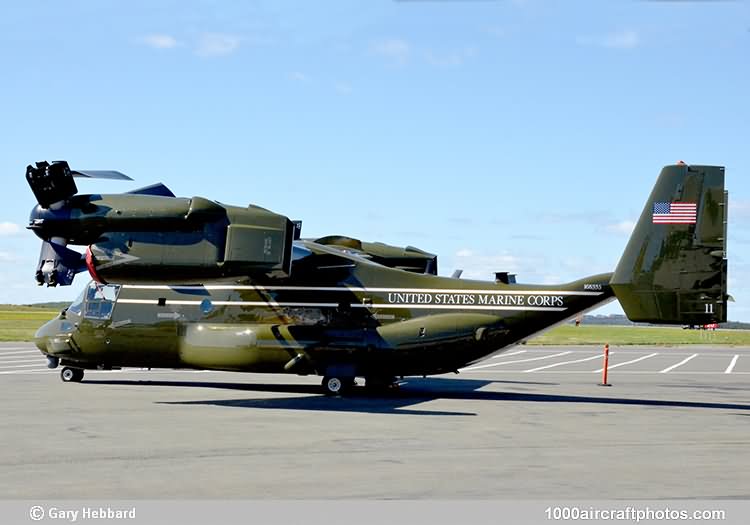12/29/2014. Remarks by Walter van Tilborg and Johan Visschedijk: "Assigned to HMX-1 (Marine Experimental Helicopter Squadron One) at MCAS Quantico, the aircraft above is pictured at the conclusion of the NATO Summit which was held at the Celtic Manor Resort in Newport, Wales, UK, September 4-5, 2014. HMX-1 'Nighthawks' is responsible for secure transportation of the President of the United States. At the summit the MV-22Bs (four of them) carried security teams on board covering the arrival of the presidential
Sikorsky VH-60Ns. The four MV-22Bs returned to the USA, staging through Lajes (Azores) and St. John's, accompanied by two Boeing KC-130Js.
The V-22 Osprey was a joint venture program of Bell Helicopter Textron, Inc and Boeing Airplane Company (after 1991 named The Boeing Company) and the winner of the USAF/USMC/USN/US Army JVX (Joint Services Advanced Vertical Lift Aircraft) competition, calling for one aircraft type suitable for a wide range of operations. The JVX was planned to operate in the assault transport (USMC), ASW/SAR/Transport (USN), Special Operations (USAF), combat transport (US Army), was intended to replace helicopter types such as the CH-46, CH-53/MH-53, H-3 and it was to become the world's first tilt-rotor design to enter production.
Work on the joint Bell and Boeing project started in 1982 and the overall configuration was similar to that of the Bell XV-15, which provided valuable experience for the V-22 multi-role convertiplane. Prototype aircraft were built by Bell (No. 1, 3, 6) and Boeing (No. 2, 4, 5), and at an early stage it was decided to use the USMC variant as so called baseline model. The V-22 Osprey (it was so named in 1985) had a very troublesome development and was in 1989/1990 close to being cancelled, while the US Army had already withdrawn from the project in 1982. The production of the Osprey was split between Boeing (fuselage) and Bell (wings, engines and final assembly).
V-22 (YV-22A/MV-22A): Designation for prototype/FSD (Full-Scale Development) aircraft the first of which was made its first vertical take off on March 19, 1989 and the first full transition was performed on September 14 of the same year. The first three aircraft served as aerodynamic/systems test bed, No. 4 was configured as USAF's CV-22A and No. 5 and 6 were planned to represent the HV-22A respectively MV-22A, but FSD aircraft No. 6 was not completed. Two of the prototypes (No. 4, 5) were lost in accidents during the test program. The V-22 (YV-22A) aircraft were powered by two 6,150 hp Rolls-Royce/Allison T406-AD-400 turbines.
CV-22A: Designation for the planned USAF model mainly intended as a long-range SAR and Special Missions aircraft as replacement for MH-53J helicopters. However, it was superseded by the improved CV-22B variant and no CV-22As were built.
HV-22A: Ship-borne combat SAR and assault variant for the USN, carrying special mission related equipment, but not built.
MV-22A: This planned USMC variant was mainly intended as successor of USMC's CH-46 helicopters used in the assault role. It had accommodation for 24 troops and provision for 12.6mm machine guns. Later it became the so called Baseline Osprey, however, it was superseded by the MV-22B. (The prototypes aircraft were often referred to as MV-22A models.)
SV-22A: Second model for USN, but for configured for the ASW and anti-shipping role and fitted with associated mission equipment. This version also was not built.
UV-22A: This was the projected US Army variant, however, the requirement was later cancelled and the US Army withdrew from the V-22 development program. The UV-22A was envisaged as possible replacement of the Grumman OV-1, Beech U-21 Ute, Beech RC-12 and similar types used for the SEMA (Special Electronic Missions Aircraft) operations. Requirement was said to be some 231 aircraft, but none were built.
VV-22A: Planned VIP/executive transport version, but development of this variant was soon halted and no aircraft were produced.
During the tests and trials it was determined that the Osprey did not meet several criteria (including range, speed) and a redesign was started to obtain sizable weights reductions and also improved engines, transmissions and fuselage construction were developed.
HV-22B: Planned improved production version intended for the USN (requirement 48 aircraft), but like the HV-22A the HV-22B model was not built.
MV-22B (V-22B): This designation was used for the improved USMC version and four additional EMD aircraft (EMD=Engineering & Development Manufacturing) were ordered in the MV-22B configuration. The first MV-22B EMD made its maiden flight on February 5, 1997. Tests and development continued till December 2001, when all flying was suspended. After a grounding period of some seventeen months, test flying was resumed mid-2002 and initial production was authorized. By spring 2010 production of some 143 (with possibly 30 more to follow) MV-22B aircraft had been authorized. The MV-22B was powered by two improved AE1107C (T406-AD-400) engines, also earmarked for the CV-22B and HV-22B.
CV-22B: This was the improved USAF variant and by late 2005 requirements stood at some fifty aircraft, mainly intended as replacement for MH-53J helicopters for Special Forces operations. Three MV-22B airframes were modified to CV-22B standard for test and R&D work and the first production CV-22B aircraft were delivered to the USAF in September 2005, with the types service entry was planned for 2009. The CV-22B aircraft were equipped for N/AW operations, low level flights and often were to be used over hostile enemy territory and therefore the aircraft carried extensive radio equipment, terrain following radar, IR imaging systems, electronic jamming systems, laser and missile warning (MWR), flare/chaff dispensers.
The first export customer was Japan which in 2014 ordered seventeen aircraft for delivery commencing in 2015. In 2014 reports surfaced that Israel might become an Osprey customer."
